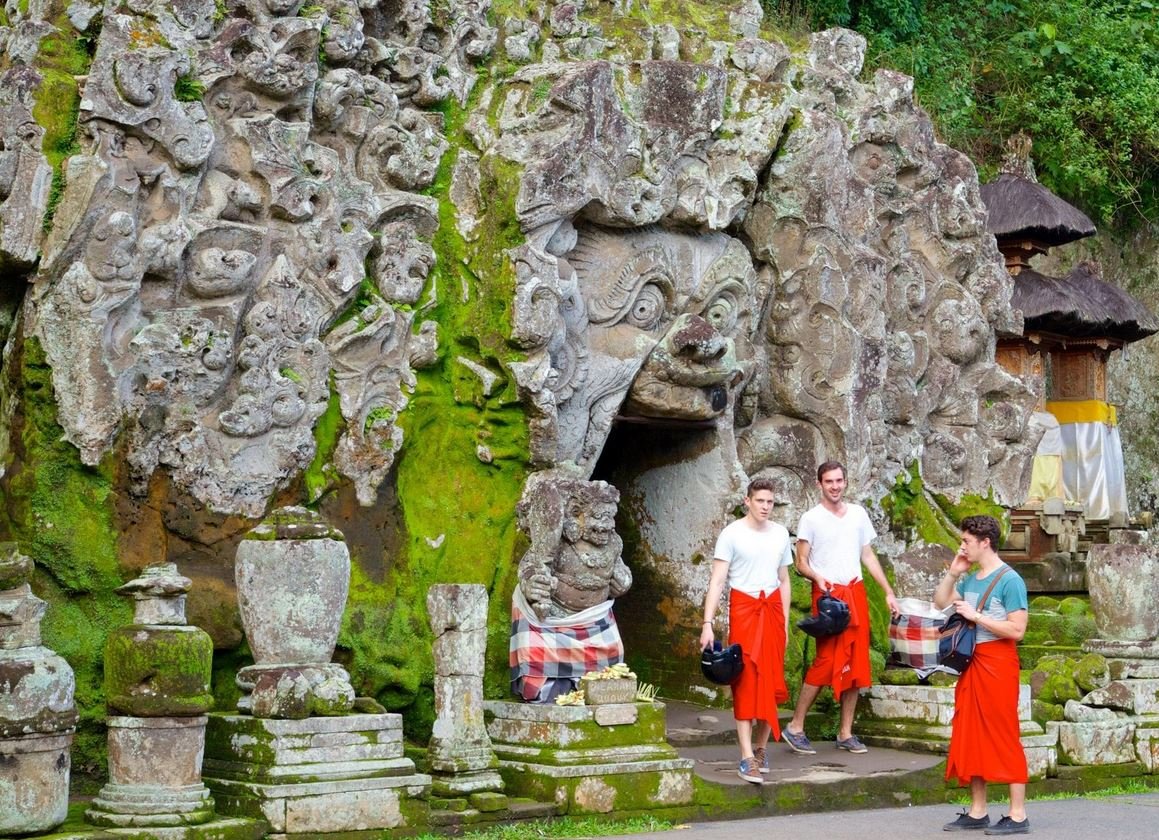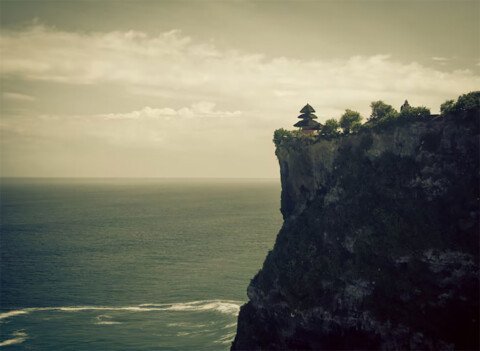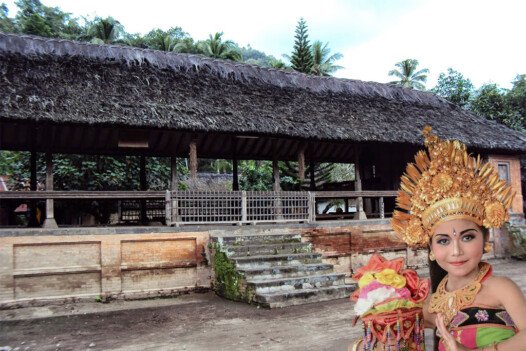Ubud – the verdant heart of Bali – is a tapestry of green rice terraces, sacred temples, artistic ateliers, and centuries-old traditions. Nestled in the island’s central highlands, this cultural crucible draws travelers with its serene landscapes and rich spiritual heritage. If you’re seeking a transcendent journey through Balinese artistry, devotion, and natural beauty, here are five enchanting places in Ubud you absolutely must visit.
1. 🛕 Goa Gajah (Elephant Cave)
A Portal into Ancient Mysticism
Goa Gajah, popularly known as the Elephant Cave, is a mysterious 11th‑century sanctuary that fuses Hindu and Buddhist motifs. The site derives its elephant moniker from a carved relief near its entrance.
The Entrance Carvings
The ornate façade features a fearsome demon’s mouth, large fangs, and bulging eyes—meant to ward off evil spirits. Exposed to centuries of weathering, the stone still retains intricate detail, beckoning the curious traveler.
Sacred Courtyard
Stepping inside reveals a meditative grotto harboring a small, moss‑covered lingam and yoni, symbols of Shiva and Shakti. Adjacent is a peaceful pool fed by ancient bathing cisterns, adding to the site’s serenity.
Royal Caves and Meditation Chambers
On one side of the courtyard lies rock‑cut sleeping chambers or meditation niches. These are thought to have been used by Buddhist monks in silent contemplation. Their stone benches evoke a sense of ritual stillness.
Captivating Surroundings
Surrounded by lush jungle, Goa Gajah resonates with the quiet hum of nature. Monkeys roam freely, lilies float above reflective pools, and shading trees lend graceful coolness.
Visitor Tips:
Arrive early (preferably by 8 AM) to avoid crowds and midday heat. Respectful attire is required: sarongs and sashes are available at the entrance. And don’t forget your camera—especially for the mossy carvings and glimmering pools.
2. 🌾 Tegalalang Rice Terraces
A Symphony of Emerald Steps
A short drive north of Ubud lies Tegalalang, iconic rice terraces that seem to cascade down the hillside in green waves. These terraces epitomize Bali’s traditional subak irrigation system, recognized as a UNESCO‑inscribed cultural landscape.
Hands‑On Farming Culture
Local farmers carve tiny levees across the terraces, creating a living quilt of rice beds. Time your visit between April and June to witness young, bright green shoots; August to October brings golden paddies ready for harvest.
Adventure on the Ridge
Stroll along narrow ridges that wind through the terraces—just wide enough for one or two people. Keep your balance and tread lightly! Some farms allow you to taste fresh rice after it’s pounded into beras kaki (a traditional snack).
Swing Amid the Greenery
Tegalalang is famed for its “jungle swing” experiences. Strap in and fly over the terraces with Ubud’s lush panorama behind you—picture‑perfect for Instagram, but also a rush of exhilaration!
Visitor Tips:
The terraces can be steep, slippery, and uneven—wear proper footwear. While some vantage points charge a small donation (about IDR 20,000–50,000), it’s worth it for an uninterrupted view. Early morning visits offer golden light and fewer tourists.
3. 🙏 Pura Tirta Empul
A Sacred Water Purification Temple
Tirta Empul, a shimmering thermal spring temple just east of Ubud, is famed for its purported healing waters and ceremonial purification rituals. Translated as “holy water spring,” this temple attracts both locals and tourists for cleansing baths and spiritual renewal.
The Enchanted Springs
At Tirta Empul, water emerges from a deep groundwater source and cascades into a rectangular purification pool with 30-plus spouts. Pilgrims and visitors alike follow a ritual: receiving blessings, washing hands, and stepping under each spout in sequence.
Ritual Offerings and Devotion
Offerings of palm leaves, flowers, incense, and fruit are placed near the pools. Priests chant mantras, blessing each devotee. The air is perfumed with lemongrass, sandalwood, and floral aromas.
Temple Complex and Pondok
Beyond the purification pool lie pavilions used for prayer and ceremony. The architecture is grand: slender columns, multi-tiered roofs, and guardian statues. A calm lotus pond adds to the mystical ambiance.
Visitor Tips:
Guests requiring sarongs and sashes can rent them onsite. Bring toiletries if you wish—the water has a mild sulfur scent. Modest entrance fees support temple upkeep. Prepare to remove your clothes before the water ritual; changing rooms are available.
4. 🎨 ARMA Museum (Agung Rai Museum of Art)
Canvas of Balinese Creativity
Founded in 1996 by Balinese cultural advocate Pande Agung Rai, ARMA is one of Ubud’s largest and most quirkily curated art museums. It showcases flooring in decorative antiques, traditional Balinese paintings, contemporary works, and rotating installations.
Traditional Balinese Paintings
Wander into colorful galleries featuring Kamasan style (elegant, narrative storytelling), Pitamaha school (rich, dense compositions), and Young Artist works full of charm and innocence.
Modern and Experimental Works
ARMA continues to support emerging Balinese artists with bold exhibitions. You may discover art that challenges tradition—mixed materials, installations, even subtle political commentary.
Cultural Programs
Every day, small Balinese dance shows animate ARMA’s gardens and terraces. There are also occasional painting classes where you can learn traditional techniques under resident artists’ guidance.
Cafe and Garden
ARMA’s café offers locally grown coffee and farm‑fresh cuisine. Outside, leafy gardens and ponds with koi fish provide a peaceful ambiance—ideal for sketching, art study, or mellow reflection.
Visitor Tips:
Check ARMA’s schedule for temple and cultural performances. Admission is about IDR 100,000. Art classes welcome walk-in participation (for a small fee, subject to availability).
5. 🐒 Sacred Monkey Forest Sanctuary
Where Nature Meets Sacred Tradition
A short stroll from the Ubud center takes you into the Sacred Monkey Forest Sanctuary—a 12-hectare nature reserve that meshes biodiversity, spiritual wilderness, and cheeky long-tailed macaques.
Architectural Mysteries
Among the ancient temples and crumbling pagodas, moss-laden statues are swallowed by fig roots and banyan trees. These structures are believed to date from the 14th century, blending seamlessly into the forest.
Mischievous Inhabitants
Over 700 wild macaques roam freely. They’ll leap from banyan limbs, nip at tourists’ hair, or snatch bags—though they start to get shy around sunset. Respect their habitat and deferred safety barriers.
Healing Springs and Shrines
Near the southwest corner you’ll find sacred purification pools and shrines nestled among fan palms and lianas. Look for signs of ritual offerings: baskets of petals, incense sticks, humble prayers.
Biodiversity and Ecology
The forest houses 186 species of trees, including towering mahogany, sacred fig, and bizarre orchid vines. It’s an ecological haven with monkeys and monkeys only being part of the dynamic web of life.
Visitor Tips:
Pay entrance fee (approx. IDR 80,000). Keep your belongings secured—monkeys are notorious kleptomaniacs. Move calmly and refrain from eye contact. Bags, glasses, and snacks are fair game to an eager monkey!
🌟 Experiencing Ubud’s Charm: More Than Just Sites
Ubud isn’t simply its temples and farms—it’s an all-encompassing cultural journey where every street, café, and gallery contributes to a living spiritual atmosphere. Here’s how to immerse yourself fully:
A. 🍲 Culinary Adventures
From bebek betutu (slow-cooked duck) in rice husk to vegan café bowls served in banana-leaf wraps, Ubud’s dining scene satisfies street-food cravings and health-conscious palates alike. Don’t miss reyog night markets for fiery sambal and grilled corn.
B. 🧘 Wellness and Mindfulness
Yoga shalas dot every alley, offering sunrise meditations, sound-healing journeys with gongs, and forest-bathing experiences. Haven’t tried a cacao ceremony? Prepare for a soul-stirring ritual focused on conscious cacao sipping, mantra, and guided reflection.
C. 🎭 Dance and Music
Traditional Balinese dance in Ubud is more than performance—it’s devotion. Watch Barong (lion-like creature) or Legong (elegant dancer) shows beneath temple pavilions, alight with gamelan music, shimmering beads, and stylized moves.
D. 🎨 Local Workshops
Try your hand at batik painting, leather carving, bamboo instrument crafting, or silver jewelry design. Meeting artisans in their studios is storytelling in action—generations of knowledge distilled into a single handcrafted piece.
E. 📿 Spiritual Insight
Seek out a friendly guru for palm readings, chakra balancing, or shadow‑work meditation. Even a casual chat with a priest at a temple winding roadside shrine can open your eyes to Bali’s underlying spiritual philosophies.
🎒 Practical Tips for Travelers
| Tip |
Detail |
| Climate & Clothing |
Ubud sits at ~350 m elevation—expect temps around 22–30 °C. Temples require sarong and sash (often provided). Breathable attire recommended. |
| Getting Around |
Scooters are popular but hire a driver for safety and local insight. Organized tours can group the five sites into a manageable day. |
| Timing Your Visit |
Start early to catch sunrise (6–7 AM) and avoid midday heat/crowds. Return after sunset for cooler vibes and dramatic lighting. |
| Respect & Etiquette |
Always remove shoes before temple entry, avoid pointing feet at altars or sacred objects, and ask permission before photographing priests or devotees. |
| Entry Costs |
Most temples and attractions charge IDR 50k–150k (~$3–10). Sarong rentals cost around IDR 10k–20k. |
🎁 Beyond the Five: Bonus Gems
Let’s sprinkle in a few more Ubud delights that don’t quite make the top five—but still deserve a spot on your itinerary:
- Campuhan Ridge Walk – A sunset‑lit grassy ridge ideal for walking and photography.
- Saraswati Temple – A lotus pond‑lined temple with daily classical dance performances.
- Ubud Market – A vibrant maze of stalls selling ikat scarves, resin carving tools, and silver earrings – great for people‑watching.
- Blanco Renaissance Museum – Set in a hilltop estate with whimsical, expressive paintings by Philippine-born maestro Antonio Blanco.
- Tegenungan Waterfall – A 15‑minute drive south, this tumbling cascade is perfect for a fresh soak.
🚀 Sample One-Day Itinerary
- 6:00 AM: Start at Campuhan for sunrise hike.
- 7:30 AM: Breakfast at local warung—try nasi campur.
- 9:00 AM: Visit Goa Gajah’s spiritual cavern.
- 10:30 AM: Head east to Tirta Empul for a purification ritual.
- 12:30 PM: Lunch at ARMA Museum café and quick gallery walkthrough.
- 2:00 PM: Travel north to Tegalalang | optional swing.
- 4:00 PM: Return to Ubud center for Sacred Monkey Forest.
- 6:00 PM: Dinner at a cozy restaurant in town.
- 7:30 PM: End the day with a Barong or Legong dance at Saraswati Temple.
🌈 Final Thoughts: Ubud’s Allure
Ubud’s essence is in the blend of its elements: the silence of its temples, the rhythm of its fields, the laughter of its monkeys, the smiles of its artisans. Whether you immerse in purification baths, trek zig-zag terraces, witness artistry in motion, or simply sip Balinese coffee under a thatched roof, the town’s charm permeates your senses.
At every corner you’ll notice traditions living vividly in everyday life—temple offerings scattered at your feet, gamelan in the marketplace, incense wafting through the air. Ubud is a place where history isn’t sealed behind glass but flows through life’s pulse.
So wander with an open heart, camera, and journal in hand. Discover that Bali’s soul isn’t defined by postcard views—but by the intangible connection you’ll feel when you honor its land, culture, and people.









